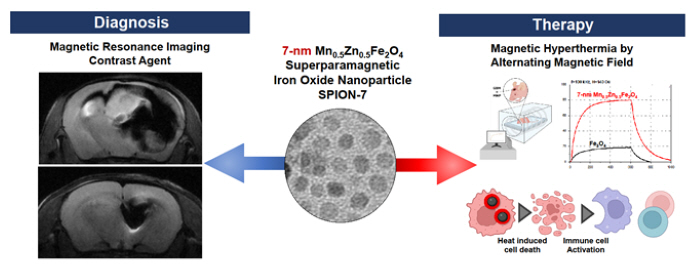Develop nanomaterials that are simultaneously used as MRI contrast agents and heat treatment materials for brain cancer
Apr 07, 2025
|
This material is a 7nm-sized manganese-zinc-iron oxide (Mn0.5Zn0.5Fe2O4) magnetic nanomaterial that has increased MRI contrast ability and thermal treatment effect compared to before. This is expected to play an important role in the development of new cancer treatments as it can simultaneously diagnose and treat cancer.
A joint research team consisting of Professor Naerang of the Department of Convergence Medicine at Seoul National University Hospital and Professor Baek Sun-ha of Neurosurgery, Professor Park Won-chul of the Graduate School of Convergence Science and Technology at Seoul National University, and Professor Rung Dae-soon of Shanghai Transportation University announced the results of the study on the 7th that developed nanomaterials (MnZn-SPION-7) and confirmed the diagnosis and treatment effect of glioblastoma through in vivo experiments.
Brain cancer (glioblastoma) is the most common tumor among primary malignant brain tumors that occur in adults and is characterized by strong resistance to existing treatments such as chemotherapy and radiation therapy. Despite recent advances in treatments such as temozolomide and concurrent chemo-radiation therapy, the median survival period of glioblastoma patients has not exceeded 15 months.
Since then, as self-thermal therapy using nanomaterials has emerged, iron oxide nanomaterials (SPION) have been developed. However, it was difficult to apply it in practice because it was not easy to optimize, such as requiring a high-intensity alternating magnetic field (AMF) and limiting the dosage. Accordingly, a method of synthesizing other atoms in the existing SPION has been attempted, but few studies have efficiently optimized the effect of MRI contrast medium and chemotherapy through precise atomic doping.
Accordingly, the research team developed a 7-nm-sized Mn0.5Zn0.5Fe2O4 iron oxide nanomaterial 'MnZn-SPION-7' by doping manganese (Mn) and zinc (Zn) into existing iron oxide through a high-temperature pyrolysis manufacturing method, and manufactured PEG-MnZn-SPION-7 by modifying the surface with methoxy-PEG-silane solvent to improve safety. Since then, in order to evaluate the stability, biosafety, biocompatibility, and diagnostic and therapeutic performance of nanomaterials, in vitro experiments and experiments were conducted and compared with existing Fe3O4 iron oxide nanomaterials (SPION).
As a result of the study, PEG-MnZn-SPION-7 was uniform in size and shape, and the stability of nanomaterials was proven by maintaining magnetic properties in aqueous solutions. And it showed a significantly higher MRI T2 emphasis effect than the existing SPION, confirming excellent performance as a contrast medium.
In terms of therapeutic effect, MnZn-SPION-7 showed a fever more than 5 times higher than that of conventional SPION in an alternating magnetic field of 140 Oe and 100 kHz (78.4 degrees Celsius vs. 15.4 degrees Celsius). In addition, when PEG-MnZn-SPION-7 was injected into glioblastoma cells, the temperature rose 26.6 degrees Celsius, causing the glioblastoma cells to disappear, and immune cell activity was induced when the same alternating magnetic field was applied six times over two weeks.
Professor Nairang (Department of Convergence Medicine) at Seoul National University Hospital said "MnZn-SPION-7 nanomaterials enable not only very high-temperature thermal treatment but also tumor tracking with MRI contrast medium at the same time" It is expected to be of great help in the development of new cancer treatments through this."
Professor Park Won-cheol (Department of Applied Bioengineering) of the Graduate School of Convergence Science and Technology at Seoul National University said, `We plan to improve patient-specific treatment and treatment by developing high-efficiency magnetic nanomaterials in the future and adding drug delivery functions through various activations of surface modification.'
Professor Baek Sun-ha (neurosurgery) at Seoul National University Hospital said, `We expect that cancer treatment using MnZn-SPION-7 nanomaterials could be a very good treatment alternative if patients with systemic cancers such as lung cancer, breast cancer, liver cancer, prostate cancer, and skin cancer relapse despite existing cancer treatment.'
Meanwhile, the study was published in the recent issue of the international journal 'Theranostics (IF: 12.4)'.
|
This article was translated by Naver AI translator.















